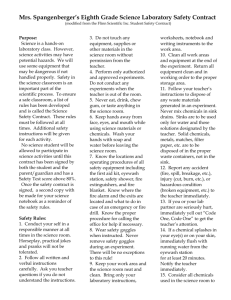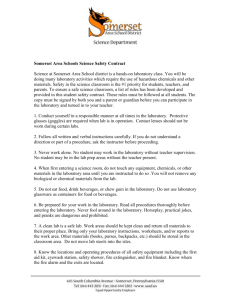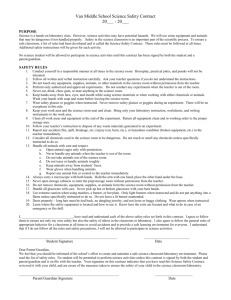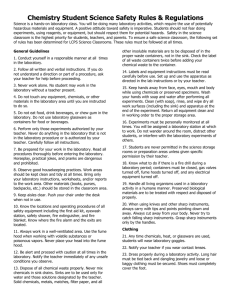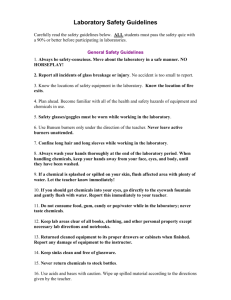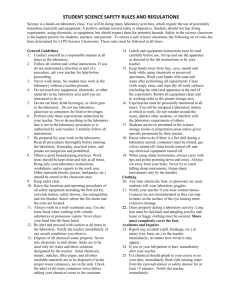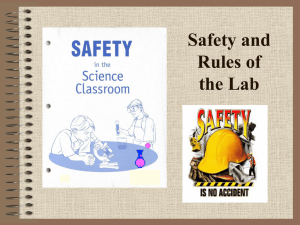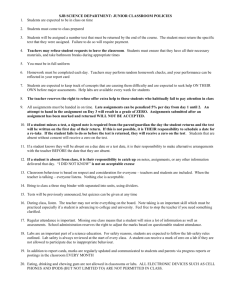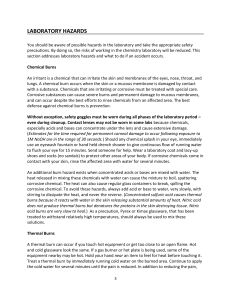Lab Safety Rules
advertisement
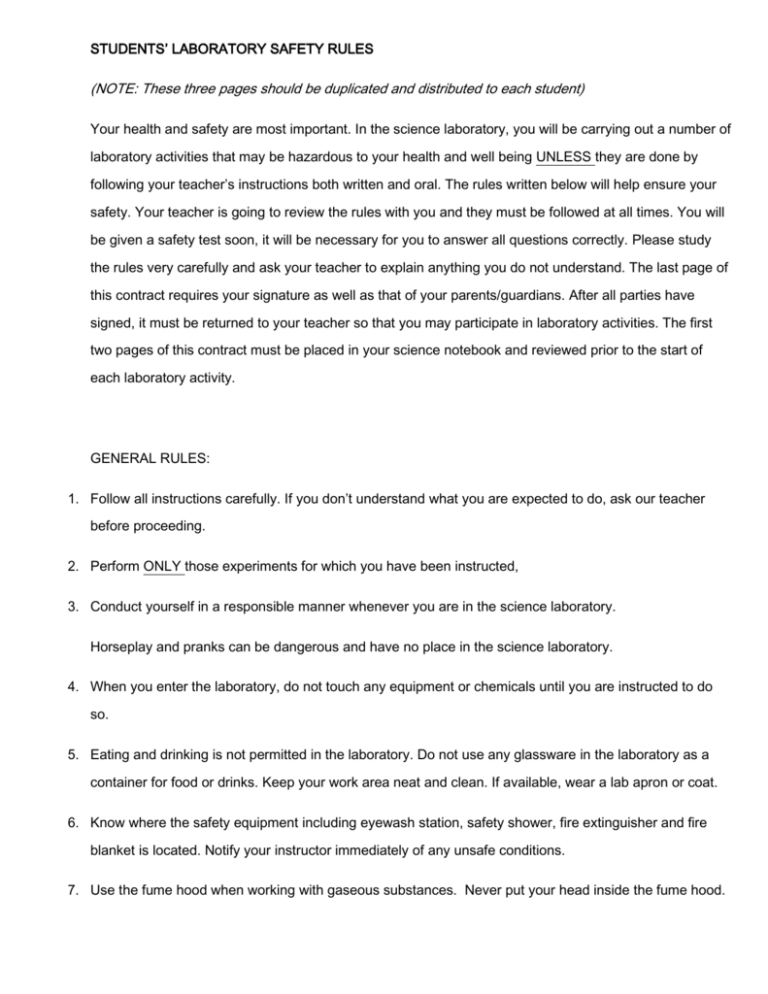
STUDENTS’ LABORATORY SAFETY RULES (NOTE: These three pages should be duplicated and distributed to each student) Your health and safety are most important. In the science laboratory, you will be carrying out a number of laboratory activities that may be hazardous to your health and well being UNLESS they are done by following your teacher’s instructions both written and oral. The rules written below will help ensure your safety. Your teacher is going to review the rules with you and they must be followed at all times. You will be given a safety test soon, it will be necessary for you to answer all questions correctly. Please study the rules very carefully and ask your teacher to explain anything you do not understand. The last page of this contract requires your signature as well as that of your parents/guardians. After all parties have signed, it must be returned to your teacher so that you may participate in laboratory activities. The first two pages of this contract must be placed in your science notebook and reviewed prior to the start of each laboratory activity. GENERAL RULES: 1. Follow all instructions carefully. If you don’t understand what you are expected to do, ask our teacher before proceeding. 2. Perform ONLY those experiments for which you have been instructed, 3. Conduct yourself in a responsible manner whenever you are in the science laboratory. Horseplay and pranks can be dangerous and have no place in the science laboratory. 4. When you enter the laboratory, do not touch any equipment or chemicals until you are instructed to do so. 5. Eating and drinking is not permitted in the laboratory. Do not use any glassware in the laboratory as a container for food or drinks. Keep your work area neat and clean. If available, wear a lab apron or coat. 6. Know where the safety equipment including eyewash station, safety shower, fire extinguisher and fire blanket is located. Notify your instructor immediately of any unsafe conditions. 7. Use the fume hood when working with gaseous substances. Never put your head inside the fume hood. 8. If a fire drill occurs during a laboratory period, be sure to close all chemicals, turn off the gas and electricity. 9. Keep your hands away from your eyes, mouth and face when using chemicals and handling preserved specimens. Be sure to wash your hands thoroughly with soap and water before leaving the laboratory. 10. It is your responsibility to take care of your lab equipment. Use it ONLY as instructed; report any damages to your teacher. 11. Clean and return all equipment when instructed to do so by your teachers. 12. When handling sharp instruments such as scissors and dissecting instruments: a. Always carry then with the tips and points in a downward position. b. Always cut away from your body c. Hold the instruments by their handle d. If the sharp instrument falls, NEVER try and catch it. 13. Wear goggles when: a. Instructed by your teacher b. Working with heat c. Working with any type of grinding, cutting, soldering, hammering rock. d. Working with chemicals There are no exceptions to this rule. 14. If chemicals should splash into your eye or get on your skin, immediately flush the eye or skin with running water from the safety shower or eyewash station for at least fifteen minutes. 15. Notify your instructor of any incidences including chemical spills, glass breakage and damaged equipment. 16. Notify your teacher of any injury no matter how slight. This includes cuts, burns and chemical splashes on any part of your body. 17. Long hair, hanging jewelry and loose or baggy clothes are hazards in the laboratory. Long Hair must be tied back. Hanging jewelry and loose clothing must be secured. Sandals and flip flops are not permitted during the science laboratory. Sneakers or closed in shoes must be worn. 18. When working with an open flame or heating materials: a. NEVER LEAVE THEM UNATTENDED. b. NEVER reach across an open flame. c. Keep hair, clothing and your hands safely away from an open flame. d. NEVER point the open end of a test tube that is being heat at yourself or anyone else. e. Hot glass and hot metal stay hot for a long time. Set them aside to cool on an insulated pad. Remember! Hot glass and cold glass look exactly alike. 19. Follow instructions for handling chemicals: a. b. c. d. e. Do not taste, touch or smell any chemicals UNLESS instructed to do so by your teacher. Do not return unused chemicals to their stock containers. Do not use the sink drains for mixing chemicals. Follow instructions for handling and the dilution of acids and bases. Dispose of all chemicals by following your teacher’s instructions. 20. Follow directions for inserting and removing glass tubing from rubber stoppers. 21. Never handle broken glass with your bare hands. Use a dustpan, brush or broom for cleaning up broken glass. You must notify your teacher and place glass in the appropriate container. 22. Do not handle chipped or broken glassware. 23. When operating electrical equipment; a. Make sure, lab station, equipment and your hands are thoroughly dry. b. Check all cords and plugs to make sure they are in good condition. Look for frayed wires and loose connections. c. Report all damaged electrical equipment to your teacher. 24. Set up equipment as far back on the lab table as conveniently possible so that it will not tip onto the floor. 25. Carefully read the label twice on any bottle prior to using it. Many chemical formulas and names look very similar, but confusing them may be dangerous. 26. Direct viewing of the sun should be avoided at all times. 27. Direct viewing of infrared and ultraviolet light sources should be avoided at all times

